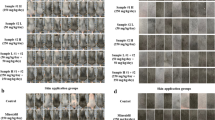Abstract
To develop a drug to treat hair loss, we evaluated the effects of Laminaria japonica extract mixed with growth factor. After topical application of the L. japonica growth factor mixture to a six-week-old C57BL/6 mouse model, analysis of hair re-growth was determined using a high-resolution hair analysis system, as well as, photographic and histologic analysis. Depilated areas were completely covered with fully-grown hair in all study groups (control group, L. japonica extract group, and L. japonica extract mixed with growth factor group) and the hair re-growth score was the highest in the group treated with L. japonica supplemented with insulin-like growth factor-1 (IGF-1). The width and length of the hair follicles showed a significant increase in the groups treated with L. japonica mixed with IGF-1, compared to the control groups. Groups treated with L. japonica mixed with growth factor showed significantly increased gene expression of IGF-1 and decreased expression of transforming growth factor (TGF)-β, compared to the control groups. We confirmed that IGF-1 was more effective in promoting hair growth than vascular endothelial growth factor (VEGF). Therefore, we suggest that L. japonica mixed with IGF-1 could successfully be used to treat patients with alopecia; however, clinical trials and additional studies on the side effects of the mixture are necessary.
Similar content being viewed by others
References
Dargie, H. J., C. T. Dollery, and J. Daniel (1977) Minoxidil in resistant hypertension. Lancet. 2: 515–518.
Park, Y., W. Choi, K. Choo, S. Yoon, and D. Park (2006) Effect of JW12 on hair growth promotion in a mice. Arch. Craniofac. Surg. 49: 61–67.
Miyai, K., T. Tokushige, and M. Kondo (2008) Suppression of thyroid function during ingestion of seaweed “Kombu” (Laminaria japonoca) in normal Japanese adults. Endocr. J. 55: 1103–1108.
Tsuboi, R. (1997) Growth factors and hair growth. Kor. J. Invest. Dermatol. 4: 103–108.
Price, V. H. and E. Menefee (1990) Quantitative estimation of hair growth. I. and rogenetic alopecia in women: Effect of minoxidil. J. Invest. Dermatol. 95: 683–687.
Shin, H. S. (2012) The effect of platelet-rich plasma on wounds of OLETF rats using expression of matrix Metalloproteinase-2 and -9 mRNA. Arch. Plast. Surg. 39: 106–112.
Fiedler-Weiss, V. C. (1987) Potential mechanisms of minoxidilinduced hair growth in alopecia areata. J. Am. Acad. Dermatol. 16: 653–656.
Hirata, N., M. Tokunaga, S. Naruto, M. Iinuma, and H. Matsuda (2007) Testosterone 5alpha-reductase inhibitory active constituents of Piper nigrum leaf. Biol. Pharm. Bull. 30: 2402–2405.
Messenger, A. G. (1993) The control of hair growth: An overview. J. Invest. Dermatol. 101: 4s–9s.
Hervert, J. M., T. Rosenquist, J. Gotz, and G. R. Martin (1994) FGF-5 as a regulator of the hair growth cycle: Evidence from targeted and spontaneous mutation. Cell. 78: 1017–1025.
Philpott, M. P., D. A. Sanders, and T. Kealey (1994) Effects of insulin and insulin-like growth factors on cultured human hair follicles: IGF-1 at physiologic concentrations is an important regulator of hair follicle growth in vitro. J. Invest. Dermatol. 102: 857–861.
Baker, J., J. P. Liu, E. J. Robertson, and A. Efstratiadis (1993) Role of insulin-like growth factors in embryonic and postnatal growth. Cell. 75: 73–82.
Ferrara, N., H. P. Gerber, and J. LeCouter (2003) The biology of VEGF and its receptors. Nat. Med. 9: 669–676.
Zhang, D., G. Lijuan, L. Jingjie, L. Zheng, C. Wang, Z. Wang, L. Liu, L. Mira, and C. Sung (2011) Cow placenta extract promotes murine hair growth through enhancing the insulin -like growth factor-1. Indian. J. Dermatol. 56: 14–18.
Bol, D. K., K. Kiguchi, I. Gimenez-Conti, T. Rupp, and J. DiGiovanni (1997) Over expression of insulin-like growth factor-1 induce hyperplasia dermal abnormalities and spontaneous tumor formation intransgenic mice. Oncogene. 14: 1725–1734.
Weger, N. and T. Schlake (2006) IGF-1 signalling controls the hair growth cycle and the differentiation of hair shafts. J. Invest. Dermatol. 126: 873–882.
Author information
Authors and Affiliations
Corresponding author
Rights and permissions
About this article
Cite this article
Lee, B.M., Park, K.S., Lee, Y.J. et al. Hair growth effects of Laminaria japonica extract and growth factor mixture on a C57BL/6 mouse model. Biotechnol Bioproc E 21, 175–182 (2016). https://doi.org/10.1007/s12257-016-0015-x
Received:
Accepted:
Published:
Issue Date:
DOI: https://doi.org/10.1007/s12257-016-0015-x




